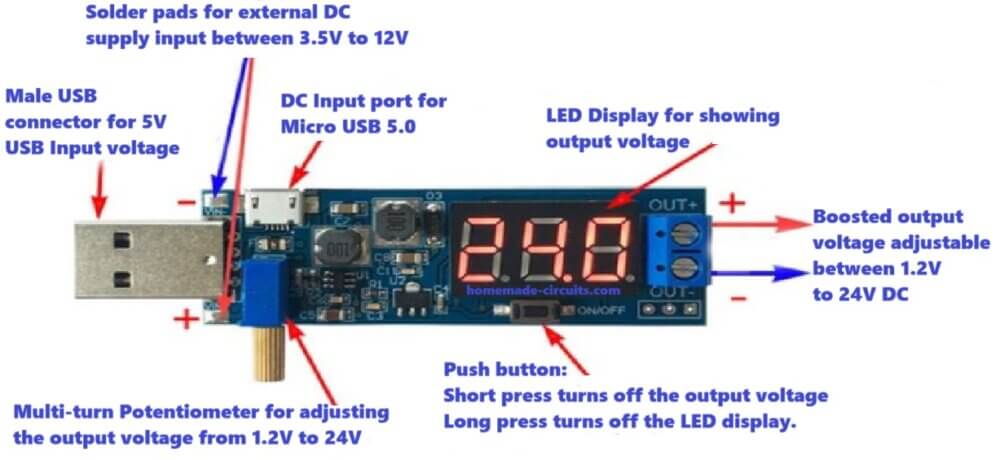This is a USB 5V to 24V Adjustable Boost Converter Module and it helps us step up a lower voltage into a higher voltage which we can adjust as needed.
Now let us go through everything in detail step by step.


Inputs – Where We Give Power
Now we got three ways to power this module.
USB Head Input (5V):
Here we just plug it into a normal USB port from a laptop, PC, power bank, or adapter.
But USB usually gives 5V only, so this is our most common input option.
Micro USB 5.0 Input:
Ok, here we got another way! We can power it with a Micro USB cable.
So if we have a phone charger or a USB adapter then we just connect it here, and it works fine.
Solderable Pad Input (3.5V – 12V):
Now, this one is different. If we do not want to use USB power then we can solder wires to these pads and give power from a battery or a DC adapter.
But we need to give between 3.5V and 12V. Less than that, it will not work; more than that, it may be dangerous for the module.
Output Voltage – What We Get as Output
Adjustable Output Voltage (1.2V – 24V):
So, here is the interesting thing! We can change the output voltage using this multi-turn precision potentiometer (the round shaft that we rotate).
If we turn it clockwise, then voltage goes up slowly. If we turn it counterclockwise, then the voltage goes down slowly.
But check this one important thing, see this is a boost converter, so the output voltage will always be equal to or higher than the input voltage.
For Example: Let us say we put 5V input, then we can adjust it from 5V to 24V. But we cannot make it lower than 5V, right?.
Display and Controls – How We Use It
Digital Display:
Now, we got this nice screen that shows us the available output voltage.
So, no need for an extra multimeter, this display helps us check the voltage directly. Pretty useful!
ON/OFF Button:
Ok, this button does two things:
If we short press it, then it turns the output ON/OFF.
If we long press it, then it turns off the display but the module keeps working.
Where We Can Use It – What It is Good For
If we need to charge devices that need a different voltage (like 9V, 12V, or 19V gadgets).
If we are working on some DIY electronics project and need a variable voltage source.
If we want to power small DC motors, LED strips, or Arduino boards with adjustable voltage.
If we have a battery that gives lower voltage and we want to boost it up for some circuit.
Some Important Things to Remember
Current Limit: How much current it gives depends on the input power.
Heat Issue: If we use high voltage, it may get hot, so we should check that.
USB Current Limit: Normal USB ports give 500mA – 2A, so if we want more power, then we need a stronger power source.

Need Help? Please Leave a Comment! We value your input—Kindly keep it relevant to the above topic!